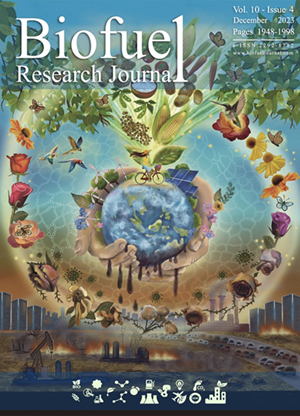丙酮-丁醇-乙醇发酵和乙醇催化升级作为丁醇生产途径的比较:技术经济和环境评估
IF 11.9
Q1 ENERGY & FUELS
引用次数: 9
摘要
丁醇是一种重要的化合物,用于生产增值产品和能量载体。丁醇的主要生产途径是传统的丙酮-丁醇-乙醇(ABE)发酵和乙醇的催化升级。另一方面,生物质作为生物燃料生产的一种有前景的基质,近年来得到了广泛的应用。然而,很少有研究对以生物质为原料的不同丁醇生产途径进行比较。鉴于此,本研究旨在(i)对催化乙醇升级进行简要综述,(ii)从经济和环境的角度比较传统的ABE发酵和催化乙醇升级工艺。使用Aspen Plus v9.0来模拟这两个过程。经济和环境评估是考虑到哥伦比亚的经济背景、门到门方法和单一影响类别进行的。考虑到1000吨/天的处理规模,传统的ABE发酵工艺对生物质丁醇的生产具有更有利的技术、经济和环境性能。它还提供了较低的净能耗(即57.9吉焦/吨丁醇)和较高的丁醇产量(即2.59吨/小时)。然而,拟议的加工规模不足以达到这两种工艺的经济可行性。为了克服这一挑战,常规ABE发酵和催化乙醇升级的最小处理规模必须分别高于1584吨/天和1920吨/天。提高两种丁醇生产途径的经济可行性的另一个关键因素是丁醇的最低销售价格。更具体地说,传统ABE发酵和催化乙醇升级的价格分别需要高于1.56美元/公斤和1.80美元/公斤。从环境影响的角度来看,传统ABE发酵工艺的潜在环境影响低于催化乙醇升级(分别为0.12 PEI/kg和0.18 PEI/kg)。本文章由计算机程序翻译,如有差异,请以英文原文为准。
Comparison of acetone–butanol–ethanol fermentation and ethanol catalytic upgrading as pathways for butanol production: A techno-economic and environmental assessment
Butanol is an important compound used as a building block for producing value-added products and an energy carrier. The main butanol production pathways are conventional acetone–butanol–ethanol (ABE) fermentation and catalytic upgrading of ethanol. On the other hand, the application of biomass as a promising substrate for biofuel production has been widely considered recently. However, few studies have compared different butanol production pathways using biomass as raw material. In light of that, the present work aims (i) to provide a short review of the catalytic ethanol upgrading and (ii) to compare conventional ABE fermentation and catalytic ethanol upgrading processes from the economic and environmental perspectives. Aspen Plus v9.0 was used to simulate both processes. The economic and environmental assessments were carried out considering the Colombian economic context, a gate-to-gate approach, and single impact categories. Considering a processing scale of 1000 ton/d, the conventional ABE fermentation process presented a more favorable technical, economic, and environmental performance for butanol production from biomass. It also offered lower net energy consumption (i.e., 57.9 GJ/ton of butanol) and higher butanol production (i.e., 2.59 ton/h). Nevertheless, the proposed processing scale was insufficient to reach economic feasibility for both processes. To overcome this challenge, the minimum processing scale had to be higher than 1584 ton/d and 1920 ton/d for conventional ABE fermentation and catalytic ethanol upgrading, respectively. Another critical factor in enhancing the economic feasibility of both butanol production pathways was the minimum selling price of butanol. More specifically, prices higher than 1.56 USD/kg and 1.80 USD/kg would be required for conventional ABE fermentation and catalytic ethanol upgrading, respectively. From the environmental impact point of view, the conventional ABE fermentation process led to a lower potential environmental impact than catalytic ethanol upgrading (0.12 PEI/kg vs. 0.18 PEI/kg, respectively).
求助全文
通过发布文献求助,成功后即可免费获取论文全文。
去求助
来源期刊

Biofuel Research Journal-BRJ
ENERGY & FUELS-
CiteScore
22.10
自引率
1.50%
发文量
15
审稿时长
8 weeks
期刊介绍:
Biofuel Research Journal (BRJ) is a leading, peer-reviewed academic journal that focuses on high-quality research in the field of biofuels, bioproducts, and biomass-derived materials and technologies. The journal's primary goal is to contribute to the advancement of knowledge and understanding in the areas of sustainable energy solutions, environmental protection, and the circular economy. BRJ accepts various types of articles, including original research papers, review papers, case studies, short communications, and hypotheses. The specific areas covered by the journal include Biofuels and Bioproducts, Biomass Valorization, Biomass-Derived Materials for Energy and Storage Systems, Techno-Economic and Environmental Assessments, Climate Change and Sustainability, and Biofuels and Bioproducts in Circular Economy, among others. BRJ actively encourages interdisciplinary collaborations among researchers, engineers, scientists, policymakers, and industry experts to facilitate the adoption of sustainable energy solutions and promote a greener future. The journal maintains rigorous standards of peer review and editorial integrity to ensure that only impactful and high-quality research is published. Currently, BRJ is indexed by several prominent databases such as Web of Science, CAS Databases, Directory of Open Access Journals, Scimago Journal Rank, Scopus, Google Scholar, Elektronische Zeitschriftenbibliothek EZB, et al.
 求助内容:
求助内容: 应助结果提醒方式:
应助结果提醒方式:


